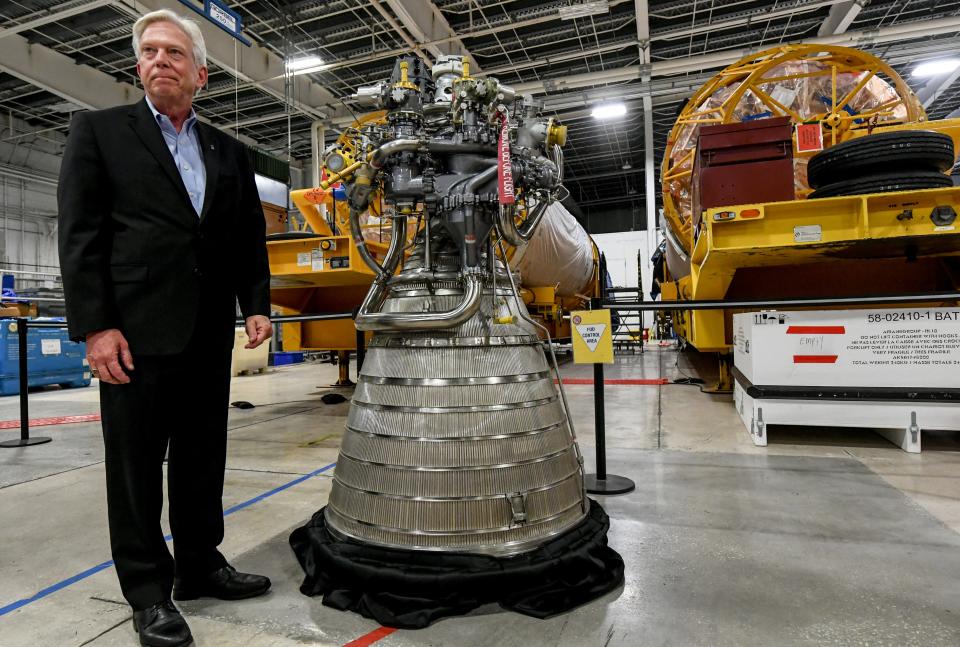ULA, Aerojet Rocketdyne mark 60-year partnership while prepping for Vulcan Centaur launch
United Launch Alliance and Aerojet Rocketdyne are celebrating the successful history of their Centaur-RL10 rocket-engine tandem, which dates back 60 years to the formative days of the Space Race.
Meanwhile, both companies are busily making preparations for their team's future. Two of Aerojet Rocketdyne's workhorse RL10 engines will power a ULA Centaur V upper stage during the maiden flight of the ULA's new Vulcan rocket on Christmas Eve at Cape Canaveral Space Force Station.
The Vulcan Centaur's instantaneous launch is scheduled for 1:49 a.m. Dec. 24 at Launch Complex 41.
“Sixty years ago today — and just five days after the assassination of U.S. President John F. Kennedy — an Atlas-Centaur launch vehicle, AC-2, took flight from Cape Canaveral Launch Complex 36A with a Centaur propelled by two RL10 engines," Julie Arnold, ULA director of strategic communications, told the media Monday during an anniversary event.

"The mission carried no payload. But the powerful Centaur scored a significant milestone: the first firing of a liquid-hydrogen, liquid-oxygen rocket engine in outer space," Arnold said.
"We're celebrating that achievement today and looking forward to what’s next in the program," she said.
Monday afternoon, ULA and Aerojet Rocketdyne marked the Centaur-RL10 combo's 60th anniversary during a media event at ULA's Advanced Spaceflight Operations Center at Cape Canaveral Space Force Station.
Inside the ASOC's cavernous "high bay," photographers snapped images and video of a life-sized chrome model of an RL10 engine alongside two ULA second-stage rockets and a trio of far-larger first-stage rockets, stored horizontally.
The venerable United States upper stage rocket that created the pathway to the Moon and every planet in the solar system – ULA's Centaur and RL10 engine from Aerojet Rocketdyne, an @L3HarrisTech company – are marking 60 years of their successful pairing. https://t.co/YpalRMoEm9 pic.twitter.com/3xklUCHGk0
— ULA (@ulalaunch) November 14, 2023
ULA is a joint venture formed in 2006 by Boeing and Lockheed Martin. Aerojet Rocketdyne was acquired by L3Harris Technologies in July for $4.7 billion.
The Vulcan Centaur mission will carry Astrobotic's Peregrine lunar lander, which is expected to touch down on the northern surface of the moon. The mission will also carry a Celestis memorial payload into deep space.
Fundamentally, the Centaur's architecture remains the same as it was in the early 1960s — with a stainless-steel tank wall thinner than a dime, said Gary Wentz, ULA vice president of government and commercial programs.
"Centaur and the R10 have made it possible for us to launch spacecraft of greater size and weight over any of the other upper-stage designs in use," Wentz said.
"It's delivered scientific missions to the sun, our moon, asteroids, every planet in the system," he said.
Jim Maus, Aerojet Rocketdyne vice president of program execution and integration, said more than 522 RL10 engines have successfully flown in space. Engineers have integrated eight major upgrades over the years to improve reliability and performance.
"It's flown on Saturn I, Atlas, Titan, Delta, and even most recently on the SLS for Artemis, powering the upper stage for that vehicle as well," Maus said.
First lady Jill Biden toured the ASOC last month alongside Veteran Affairs Secretary Denis McDonough. The duo visited Brevard County's Space Force facilities during an afternoon promotional swing touting the White House's Joining Forces initiative, which supports military families.
When are the next launches from the Space Coast?
SpaceX's Starlink 6-30 mission launched Monday night.
Then later this week, a National Geospatial-Intelligence Agency navigational warning shows another 4½-hour rocket launch window will open late Friday night and extend beyond midnight into Saturday morning. SpaceX has not yet confirmed this mission:
About: A SpaceX Falcon 9 rocket will launch a batch of Starlink internet satellites from Cape Canaveral Space Force Station.
Launch window: 11 p.m. Friday to 3:11 a.m. Saturday.
Location: Launch Complex 40.
Trajectory: Southeast.
Local sonic boom: No.
Booster landing: Drone ship out on the Atlantic Ocean.
Live coverage: Starts 90 minutes before liftoff at floridatoday.com/space.
More: Rocket launch schedule: Upcoming Florida launches and landings
Rick Neale is a Space Reporter at FLORIDA TODAY (for more of his stories, click here.) Contact Neale at 321-242-3638 or rneale@floridatoday.com. Twitter/X: @RickNeale1
This article originally appeared on Florida Today: ULA, Aerojet Rocketdyne mark 60-year rocket-engine partnership at Cape

